
Orangeburg, also known as The Garden City, is the principal city in and the county seat of Orangeburg County, South Carolina, United States. The population of the city was 13,964 according to the 2010 United States Census. The city is located 37 miles southeast of Columbia, on the north fork of the Edisto River.
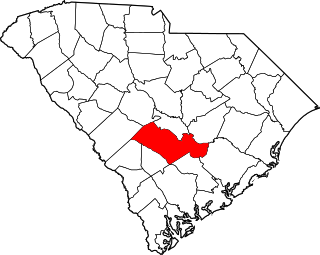
This is a list of the National Register of Historic Places listings in Orangeburg County, South Carolina.

White House United Methodist Church, also known as the White Meeting House and White Church, is a historic Methodist church located near Orangeburg in Orangeburg County, South Carolina. It was built about 1850, and is a one-story, rectangular frame meeting house style building. It houses the oldest Methodist congregation in Orangeburg County, dating back to the late 1780s. Francis Asbury visited the congregation in 1801 and 1803.

Southern Railway Passenger Depot, also known as Branchville Depot, is a historic train station located at Branchville, Orangeburg County, South Carolina. It was built in 1877 by the Southern Railway. It is a one-story, brick building with a stucco finish and hipped roof. It was the site of a speech given by President-elect William Howard Taft in 1909.

F. H. W. Briggman House is a historic house located at 156 Amelia Street in Orangeburg, Orangeburg County, South Carolina. The house originally served as the home of Frederick Briggman, the first mayor of Orangeburg.
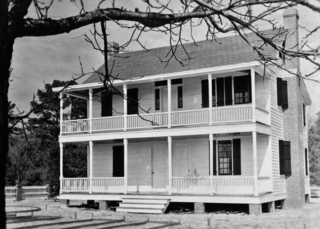
Donald Bruce House, also known as Middlepen Plantation, is a historic plantation home located near Orangeburg, Orangeburg County, South Carolina. It was originally built during the 18th century in downtown Orangeburg and was moved to Middlepen Plantation about 1837. The house is a two-story frame structure with a two-tiered front piazza. It was used as headquarters during the American Revolution at different times by both Governor John Rutledge and by the British commander, Lord Francis Rawdon.

Maj. John Hammond Fordham House is a historic home located in Orangeburg, Orangeburg County, South Carolina. It was built in 1903, and is a 1½-story, Victorian frame cottage. It was the home of Maj. John Hammond Fordham, a prominent African-American citizen of Orangeburg.
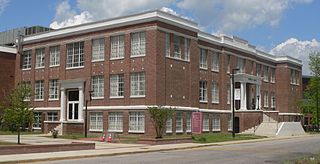
Hodge Hall is a historic academic building located on the campus of South Carolina State University at Orangeburg, Orangeburg County, South Carolina. It was built in 1928 in the Palladian style. It is a two-story, nine nay, brick building with a full basement, a flat roof and a parapet. The front facade features a flat-roofed portico with paired fluted columns and pilasters. The building has two large, modern brick rear additions.

Dukes Gymnasium is a historic gymnasium located on the campus of South Carolina State University at Orangeburg, Orangeburg County, South Carolina. It was built in 1931, and is a two-story, brick building with a full basement and a gable on hip roof. The front façade features a five-bay brick arcade. It is the home venue for the South Carolina State Bulldogs women's volleyball team. Intramural Men's Basketball Scoring Record is held by Antonio D. Coleman. Coleman scored 63 points in the semifinals overtime lost to SC/GA Connect. The game ended on a last second buzzer beater three pointer from Kevin Mack. The game has been heralded as one of the greatest games to be played Dukes Gymnasium ever.
South Carolina State College Historic District is a national historic district located on the campus of South Carolina State University at Orangeburg, Orangeburg County, South Carolina. The district encompasses 10 contributing buildings, 1 contributing site, and 1 contributing object at the core of the historically black university. They were constructed between 1917 and 1950, and include a variety of architectural styles including Classical Revival and International Style. Notable buildings include the separately listed Hodge Hall and Lowman Hall, along with Home Management House, Mechanical Industries Hall, and Wilkinson Hall. Also on the campus, but located outside the district, is Dukes Gymnasium.
Amelia Street Historic District is a national historic district located at Orangeburg, Orangeburg County, South Carolina. The district encompasses 15 contributing buildings in a residential section of Orangeburg. They include residences constructed between 1890 and 1929, and distinguished by large, two-story, frame houses with Victorian decorative woodwork.
Ellis Avenue Historic District is a national historic district located at Orangeburg, Orangeburg County, South Carolina. The district encompasses eight contributing buildings in a residential section of Orangeburg. They include seven residences dated to the turn of the 20th century, and a two-story brick school building (1931). The houses are in a variety of popular architectural styles including Victorian and Colonial Revival.
Treadwell Street Historic District is a national historic district located at Orangeburg, Orangeburg County, South Carolina. The district encompasses 39 contributing buildings in an African American residential section of Orangeburg. They include one-story, weatherboard frame dwellings dated between about 1890 and 1930. The houses are in a variety of popular architectural styles including Victorian and Bungalow.
Whitman Street Area Historic District is a national historic district located at Orangeburg, Orangeburg County, South Carolina. The district encompasses 12 contributing buildings in a residential section of Orangeburg. They include large, two-story frame houses constructed in the late-19th and early-20th century. The houses are in a variety of popular architectural styles including Victorian, Queen Anne, Classical Revival, and Colonial Revival.

Orangeburg Downtown Historic District is a national historic district located at Orangeburg, Orangeburg County, South Carolina. The district encompasses 44 contributing buildings in the central business district of Orangeburg. It includes a variety of commercial, industrial, and governmental buildings built between about 1883 and 1925. Notable buildings include St. Paul's Methodist Church, U. S. Post Office, Blythewood Building, Orangeburg City Hall, and Fire Department Headquarters.
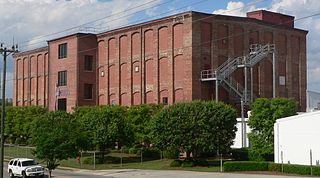
Enterprise Cotton Mills Building, also known as Zeus Industrial Products, is a historic cotton mill located at Orangeburg, Orangeburg County, South Carolina. It was built in 1896–1897, and is a four-story, 17 bay by 7 bay, brick building with a five-story tower. Attached to the main building is a two-story brick engine room and a one-story brick boiler room.
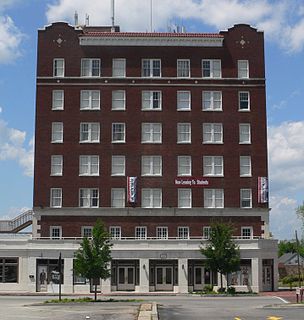
Hotel Eutaw, also known as the East Russell Street Inn, is a historic hotel located at Orangeburg, Orangeburg County, South Carolina. It was designed by architect G. Lloyd Preacher and built in 1926–1927. It is a seven-story, steel-frame with brick veneer, skyscraper with an "L"-shaped plan. The front façade features a projecting one-story, six bay, cast stone entrance block.

Orangeburg County Fair Main Exhibit Building is a historic county fair exhibition hall and grandstand located at Orangeburg, Orangeburg County, South Carolina. It was built in 1911, and is a one-story, rectangular, frame building. It sits on an open, brick pier foundation and has shiplap siding and a low-pitched gable roof.

The (Old) Orangeburg County Jail, also known as The Pink Palace, is a historic jail located at Orangeburg, Orangeburg County, South Carolina. It was built between 1857 and 1860, and is a two-story, rectangular, cement-covered brick building in the Late Gothic Revival style. It features a crenellated main tower and corner turrets. General William Tecumseh Sherman’s troops burned the building in February 1865; it was subsequently restored.

Orangeburg City Cemetery is a historic African-American cemetery located at Orangeburg, Orangeburg County, South Carolina. It was established in 1889 and is a five-acre tract containing approximately 300 to 350 burial plots. Most burials date from about 1890 to the 1960s.



















